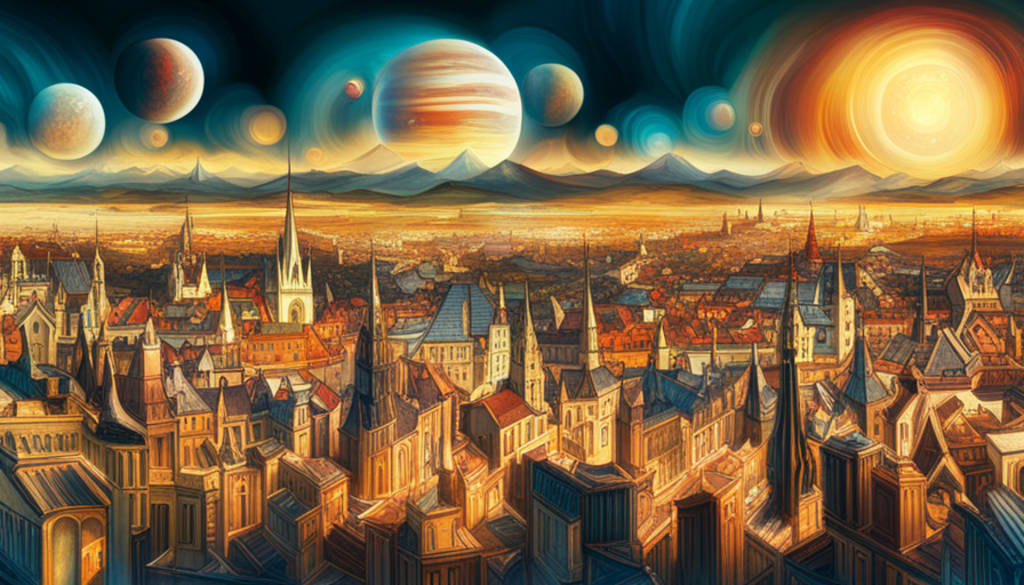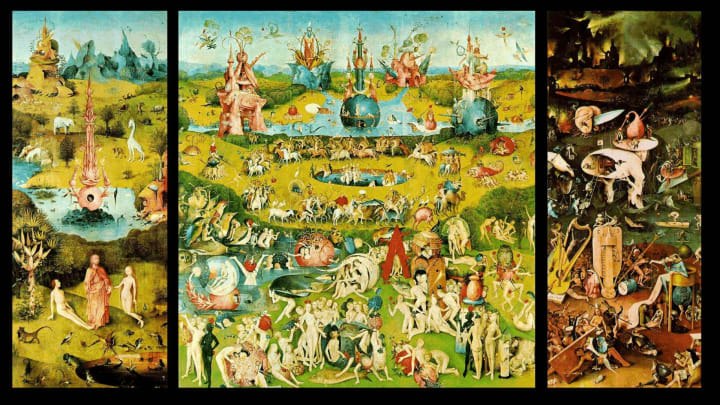Art is Where Words Fail
And Pure Expression Unfolds

Art possesses an extraordinary capacity to transcend the limitations of explicit verbal communication, connecting with humans on a profound level, reaching down into their souls, and finding a point of visceral connection. We find this in the works of influential artists such as William Blake and Hieronymus Bosch, who skillfully evoke emotions, ideas, and experiences through their creations.
William Blake, a visionary poet and artist, employed a distinctive approach in his call-and-response poems. Through the skillful use of contrasting elements and vivid imagery, Blake evoked symbolism that connected with the collective unconscious, inviting readers to engage with profound and relatable themes. Rather than dictating how the audience should feel, Blake's poems create a sensory experience that conveys the interplay between good and evil, the sacred and the profane, leaving room for individual interpretation and emotional response. In this poem The Tyger, he tackles the complex disagreement between the divine and the monstrous, using the tiger as a metaphor for God's more troublesome manifestations.
Tyger Tyger, burning bright,
In the forests of the night;
What immortal hand or eye,
Could frame thy fearful symmetry?
In the Lamb, conversely, he offers a whimsical interpretation of the delicate hand of God in creating what is beautiful and pleasant.
Little Lamb ...
Dost thou know who made thee
Gave thee life & bid thee feed.
By the stream & o'er the mead;
Gave thee clothing of delight,
Softest clothing wooly bright;
Gave thee such a tender voice,
Making all the vales rejoice!
Indeed, these poems show a persistent disagreement in the Judeo-Christian tradition. How could God create both beauty and horror with the same brush? This technique encourages readers to embark on a personal journey, exploring the inherent tension and ambiguity within these universal dichotomies.
Shifting from the realm of poetry to visual art, Hieronymus Bosch's masterpiece, "The Garden of Earthly Delights," provides a striking example of art's ability to swiftly convey complex ideas without excessive description. This mesmerizing triptych painting vividly portrays Hell, teeming with nightmarish creatures engaged in grotesque acts. Bosch's surrealistic imagery and meticulous attention to detail transcend verbal expression, immersing viewers in a visceral experience. Each peculiar element within the painting intensifies the sense of horror, from dismembered limbs adorning bird monsters to sinners subjected to torturous instruments. Through these mesmerizingly odd details, Bosch's painting elicits a profound emotional response, effectively communicating the dark and tumultuous nature of Hell in a manner that words alone cannot capture.

Art, with its evocative expression, empowers artists to communicate feelings, ideas, and experiences that surpass the limitations of the human voice. William Blake's call-and-response poems beckon readers to explore the complexities of universal themes, while Hieronymus Bosch's painting immerses viewers in a nightmarish realm, stirring emotions and providing a vivid understanding of Hell. These examples illustrate the unique power of art to transcend words and deeply resonate with individuals.
Throughout history, artists have harnessed various techniques and mediums to surpass the limitations of language. Visual art, including paintings, sculptures, and installations, possesses a unique ability to communicate on a visceral level. Colors, forms, textures, and compositions harmonize to evoke emotions, provoke thought, and transport viewers to different realms. By transcending verbal constraints, visual art taps into viewers' intuitive and emotional responses, fostering a profound connection.
Similarly, poetry, with its mastery of descriptive language, rhythm, and metaphor, harnesses the power of words to transcend flat descriptions. Poets skillfully select and arrange words in evocative ways, utilizing literary devices to create imagery, stir emotions, and capture experiences that defy straightforward expression. The interplay of sound, metaphor, and rhythm in poetry transports readers beyond the boundaries of mere verbal communication, immersing them in the nuanced depths of human experiences.
We should not ignore that the limits of verbal expression are also defied by music, dance, and performance art. These arts embody the essence of non-verbal communication, where emotions and narratives are conveyed through movement, rhythm, melody, and expressive delivery. Even lyrics in music have a way of condensing emotions, allowing for raw emotionality to be conveyed. These art forms tap into the core of the human experience, facilitating a direct and immediate connection with the audience. For example, Leonard Cohen's Hallelujah is an enduring song and this is because it can convey a multitude of emotions in only a few lines.
And, maybe there's a God above
But all I've ever learned from love
Is how to shoot somebody who outdrew you.
The idea of love being a duel between two gunslingers is something to which most people can relate. Love is not a simple emotion. It is often intermingled with an array of other emotions. You can love someone but not like them because their behaviors make them unlikeable. What is the word for this sub-emotion? The lack of words for specific human experiences like this is where art finds traction in our hearts and minds.
Words for conveying certain emotions do not often exist, so the need for alternative expression is important to maintaining sanity and fostering connection. Sometimes we find a phrase that conveys these ineffable concepts, but a phrase is not always needed. Words are not always necessary where art is concerned. The evocative power of music and movement transcends the need for words, as they speak to our emotions and bypass the intellect, creating a profound and often transcendent experience.
Art's ability to surpass verbal communication lies in its capacity to tap into the intuitive, emotional, and sensory realms of human perception. By engaging the senses, emotions, and imagination, art opens doors to profound understanding, connection, and contemplation that exceed the limitations of words alone. It invites individuals to embark on personal journeys of interpretation and meaning-making, fostering a rich dialogue between the artist, the artwork, and the audience.
Through visual art, poetry, music, and performance, artists delve into the depths of the human experience, evoking emotions, capturing complex ideas, and connecting with audiences on a profound level. By transcending explicit descriptions, art fosters a direct and immediate connection, enabling a shared experience that has evolved beyond the boundaries of language. In this way, art serves as a testament to the power of creativity and its ability to communicate what words alone cannot express.
About the Creator
Mack Devlin
Writer, educator, and follower of Christ. Passionate about social justice. Living with a disability has taught me that knowledge is strength.
We are curators of emotions, explorers of the human psyche, and custodians of the narrative.






Comments
There are no comments for this story
Be the first to respond and start the conversation.